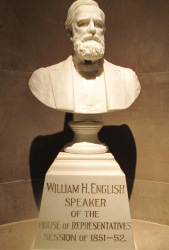
U.S. Congressman from Indiana
- Democratic candidate for U.S. Vice President
- Indiana State Representative
- Secretary of the Indiana Constitutional Convention
Bust Location
Statehouse Rotunda, 4th floor, Facing north, west corner
Born
Lexington (Scott County)
Lived
Indianapolis
William Hayden English was born on August 27, 1822 in Lexington, Indiana. His father, Elisha English, was active in Indiana politics, serving as the sheriff of Scott County, a representative and senator in the Indiana General Assembly and a United States Marshal. After years of education in local schools, English attended Hanover College for three years, then studied law independently and was admitted to the Indiana bar in 1840. He was only 18 years old. In that same year, English was a delegate to the Democratic State Convention in Indianapolis. When John Tyler assumed the Presidency, he appointed English as postmaster of Lexington.
In 1843, English was elected clerk of the Indiana House of Representatives. He only served in this position for one year, as he was appointed to serve in the U.S. Treasury Department in Washington, D.C. in 1844.58 While he was serving in this capacity, he met and married Emma M. Jackson of Virginia (1847). They went on to have two children: a son, William E. English, and a daughter, Rosalind. In 1850, English left his position in the Treasury Department to serve as a clerk of the Claims Committee of the U.S. Senate. That same year, English served as the secretary of the Indiana constitutional convention, which met in Indianapolis with the goal of revising the state constitution.59
After serving in such a prominent position, English was elected to represent Scott County in the Indiana House of Representatives, serving as the Speaker of the House in the 1851-52 session. In 1853, English was elected to the U.S. House of Representatives. During his first term in the U.S. House, English worked on the Kansas-Nebraska Act (1854) which repealed the Missouri Compromise, allowing residents of western territories to vote on the slavery issue themselves.60
Despite the unpopularity of the Kansas-Nebraska Act, English was re-elected for a second term, and went on to serve two more terms. English decided not to run for re-election in 1860 and retired to private life in 1861. Two years later, English moved to Indianapolis, where he helped to organize the First National Bank, becoming its first president. He held that position until 1877, during which time he was an integral member of the city’s business life.61
In 1865, as he was becoming a prominent figure in Indianapolis, English decided to purchase the home of W.S. Hubbard, located on Governor’s Circle (now Monument Circle). He then moved his wife and children into the home.62 Over the following 15 years, English purchased and removed homes, commercial buildings and a church which were also within the northwest quadrant of the Circle. He built a theater and opera house there, modeled after the New York Grand Opera House. The stage was the largest in the city at the time. The official opening of the theater occurred on September 27, 1880, with a production of Hamlet.63
The same year that the English Opera House opened, English was nominated as the Democratic candidate for the vice presidency as the running mate of General Winfield Scott Hancock. The two lost the election by less than 10,000 votes, and William Hayden English retired from politics afterward.64 In 1884, English began the construction of a hotel to connect to the English Opera House. In 1893, English filled a vacancy on the Monument Commission and helped to plan and finance the Soldiers and Sailors Monument. In 1896, he had his home on the Circle removed to make way for the hotel to extend south toward Market Street. The hotel and opera house stood as landmarks on the Circle until 1948, when they were both demolished and replaced by a J.C. Penney store.65
Towards the end of his life, William Hayden English expressed an interest in Indiana history, serving as the president of the Indiana Historical Society from 1886-1896. He also published two historical books, "Conquest of the Country Northwest of the River Ohio, 1778-1783" and "Life of General George Rogers Clark".66 English died on February 7, 1896 in his room at the English Hotel in Indianapolis. He had been sick for six weeks prior to his death, and the cause was inflammatory rheumatism complicated by heart disease.67 English’s body lay in state in the Indiana State House, where over 15,000 people came to pay their respects. He was buried at Crown Hill Cemetery in Indianapolis.68
Bust History
The bust is located on the third floor of the Indiana Statehouse, in a niche on the south corner outside of the Rotunda, facing east.
